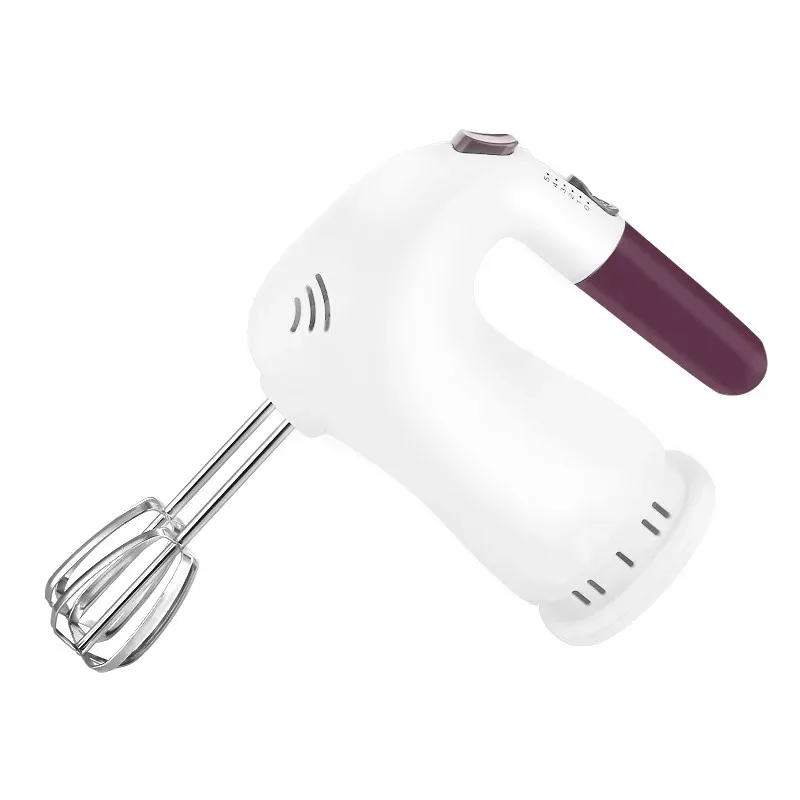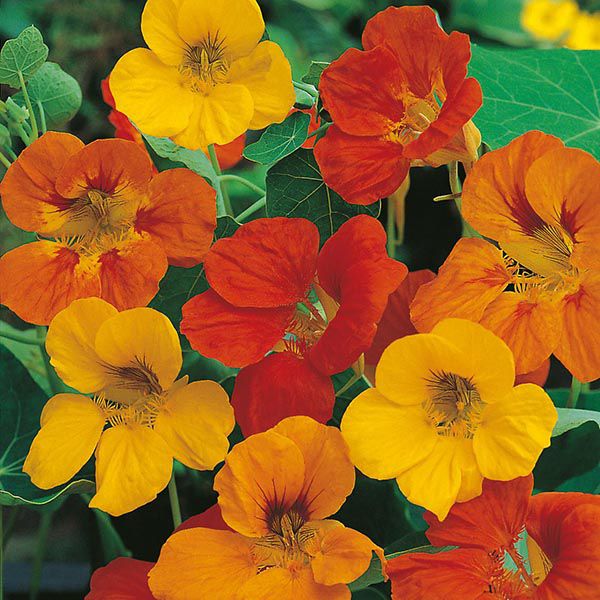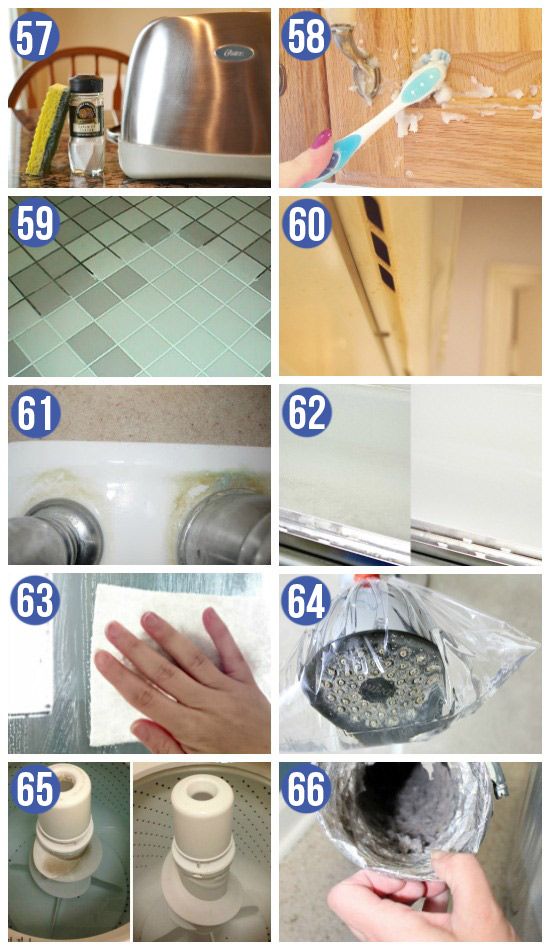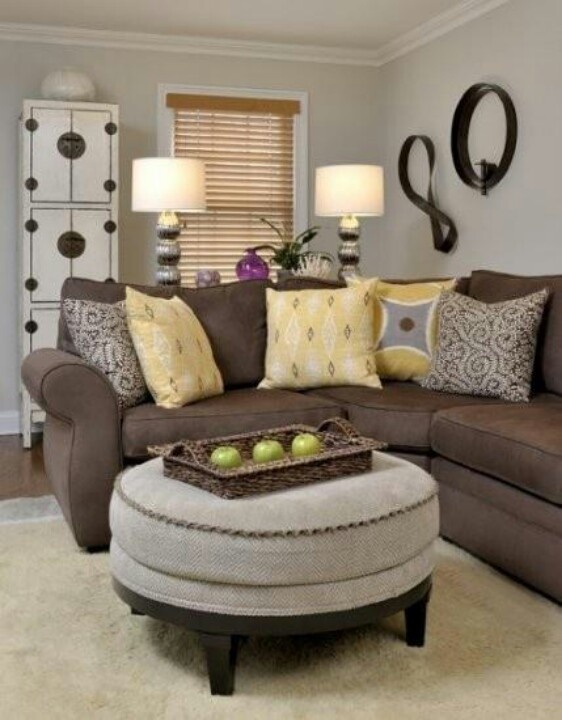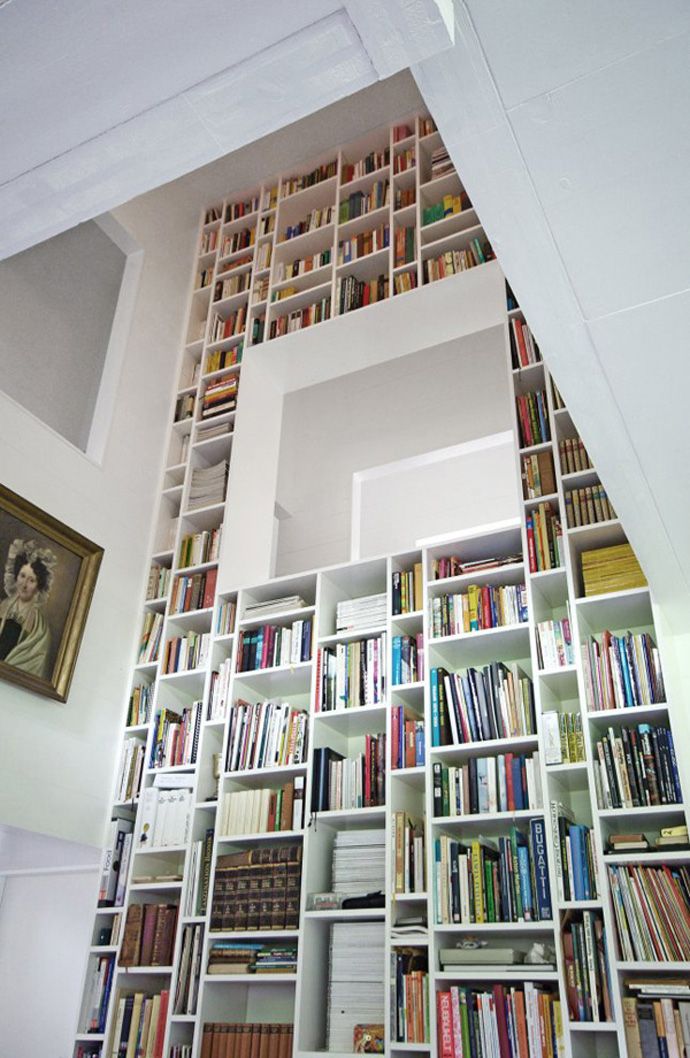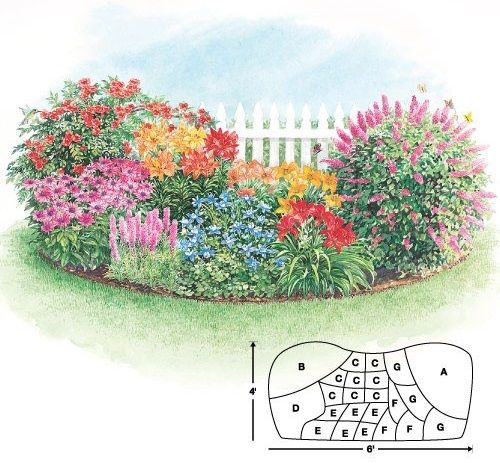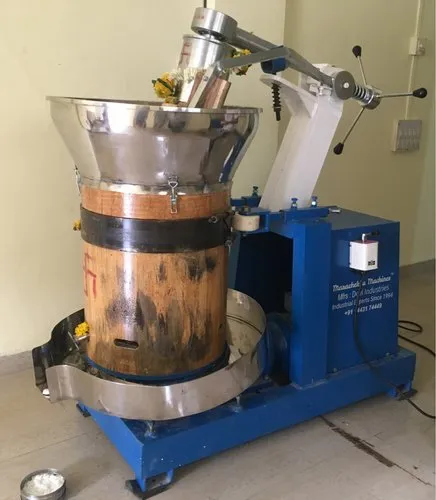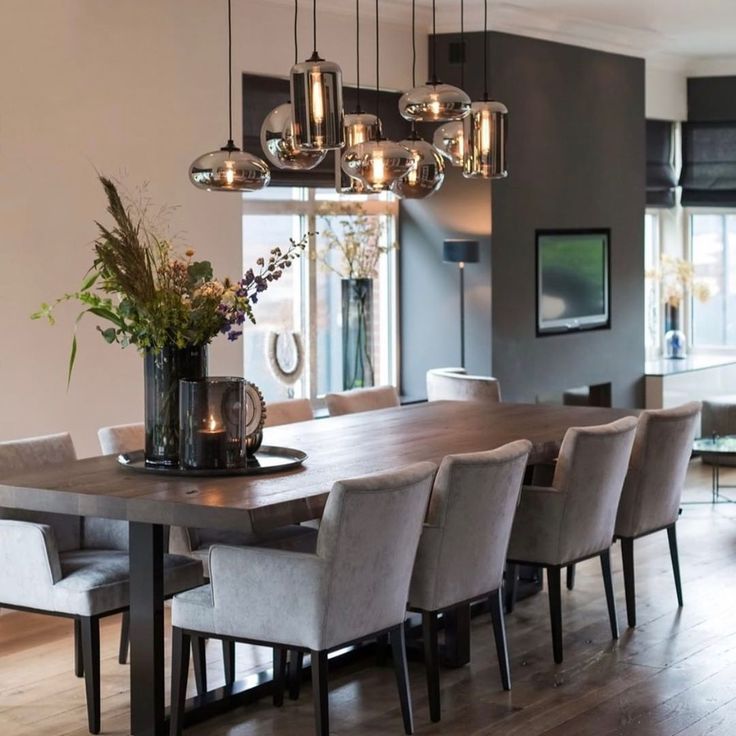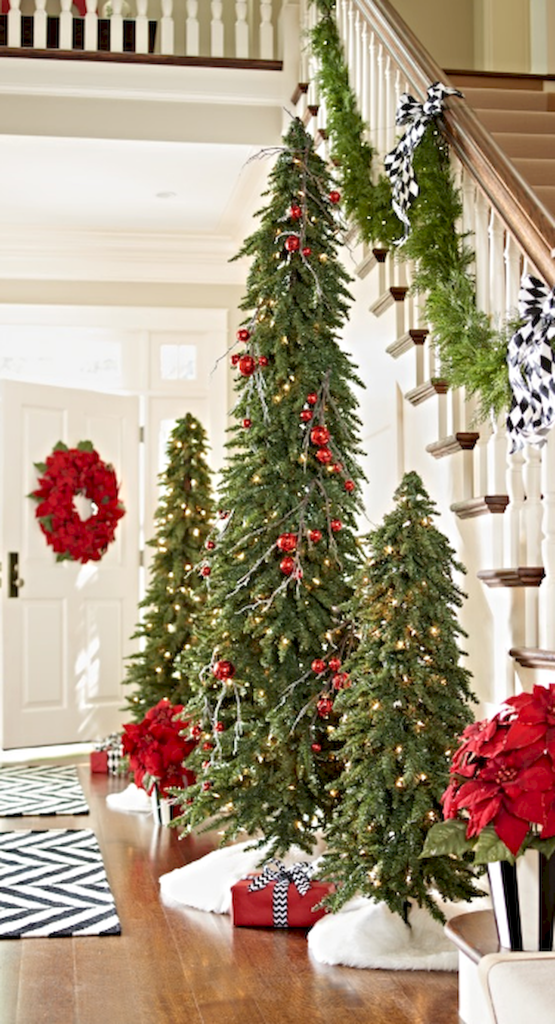Engineered wood flooring for kitchens
Wood kitchen flooring: Is wood flooring suitable for kitchens? The experts explain
(Image credit: Christopher Horwood)
Many homeowners are unsure whether wood kitchen flooring is an appropriate choice for their space.
Wood is an ultra-desirable flooring choice because it has natural beauty, appealing warmth, durability and a look that won’t be overtaken by the tides of interiors fashion. But is it suitable for kitchens?
Both heat and moisture in the environment affect wood, causing warping, swelling and shrinkage and, because of the activities that take place in a kitchen, wood kitchen flooring is far more exposed to changes in temperature and humidity than if it was in a living space or a bedroom.
Many different kitchen ideas feature wood flooring, and today it looks the part in both contemporary rooms, farmhouse kitchens and a whole host of designs in between, showing that our passion for the material is undimmed.
So should wood be seen as a good kitchen flooring option? We’ve asked the experts to provide the inside track on solid and engineered timber, as well as reclaimed wood, so you can find out if wood kitchen flooring is suitable for your space.
(Image credit: Ward & Co)
Is wood kitchen flooring a good option?
‘The average kitchen is a hive of activity and a hub for families to congregate in during the course of the day, so it is essential the choice of flooring is able to withstand this,’ says Rosie Ward, creative director of London-based interior designers Ward & Co .
‘Wood is not only a lovely natural resource that looks fantastic, but it also has great durability and therefore suits most kitchens well. In terms of style, I often like to keep the same flooring from one room to another; it provides great continuity and flow across spaces as well as helping to achieve a level of calmness.’
Bear in mind, though, that both the composition of your household and the kitchen’s location in the home should inform your decision, as a wood kitchen flooring won’t be right for every situation.
‘Many of my clients love the touch of warmth that wood floors lend their kitchens,’ says Benjamin Johnston of Benjamin Johnston Design ‘But regardless of whether they are engineered or real wood, they can take a beating in this high-traffic space.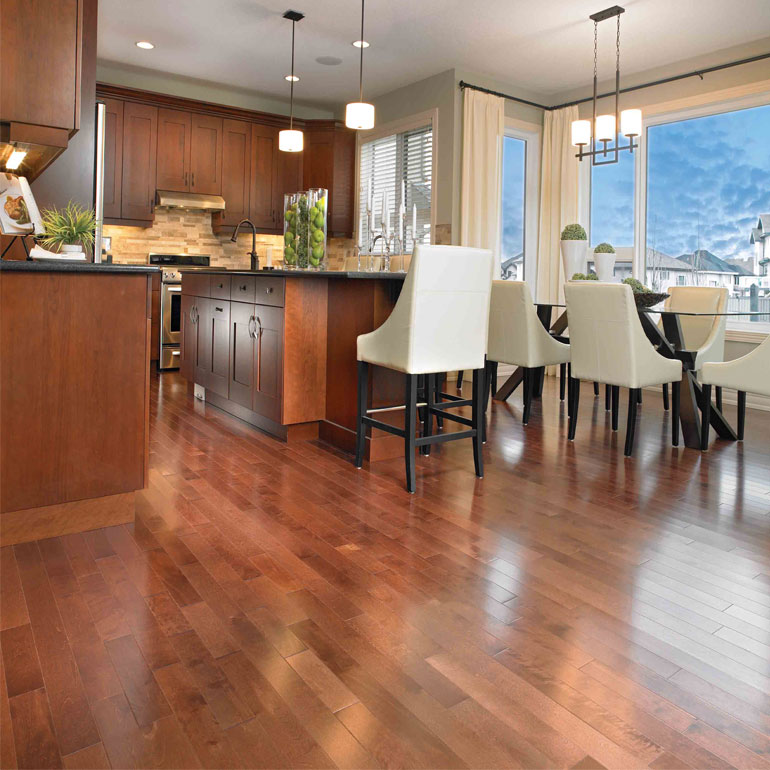
'Kitchen floors are faced with spills of all kinds and the occasional drop of a dish or utensil while cooking. If you prefer a pristine or highly polished look, I suggest steering away from wood floors in your kitchen.' – so you may want to consider stone or different kitchen floor tile ideas instead.
‘On the other hand, if you prefer a home that celebrates a relaxed, casual environment, any dings and dents wood kitchen flooring might take on over time can play up the charm of a well-loved and oft-used kitchen.
'If you decide to go with wood kitchen flooring, consider a matte finish (in both real and engineered options) as it tends to be more forgiving, or go with reclaimed wood flooring that already has an inherent character from its previous life.’
The kitchen’s position should count when selecting the flooring too, because if it’s the space accessed directly from the garden, a pool deck or the garage, damp and dirt could get regularly tracked onto it, causing harm to the surface.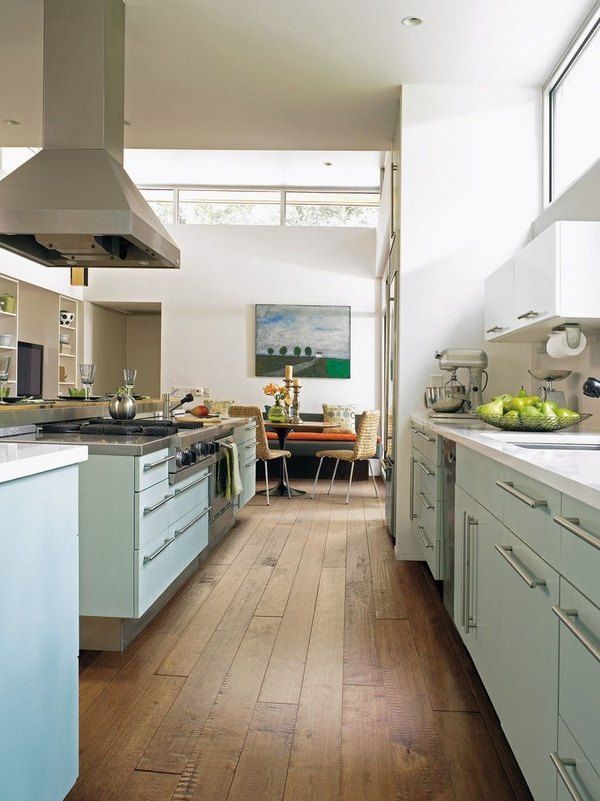
Although wood can be refinished if it’s damaged, these scenarios should give you pause before investing in a wood kitchen flooring, as other choices might need less care to stay looking their best.
Is wood flooring suitable for kitchens?
Yes, wood flooring is suitable for kitchens – but some wood types and constructions more than others. We've gathered the experts' advice on all types of wood kitchen flooring, and the answers to your wood flooring questions.
Solid wood kitchen flooring
(Image credit: Junckers)
If nothing but a solid wood floor appeals, is this a sound pick for a kitchen?
‘Wooden floors are a popular choice for kitchens as they feel warm under foot and lend an element of natural beauty to any style of kitchen, contemporary or traditional,’ says David Papworth, general manager of Junckers .
‘Shiny surfaces and hard materials often found in kitchens are instantly softened with a wood kitchen flooring; it gives the room a balance and makes it look more homely.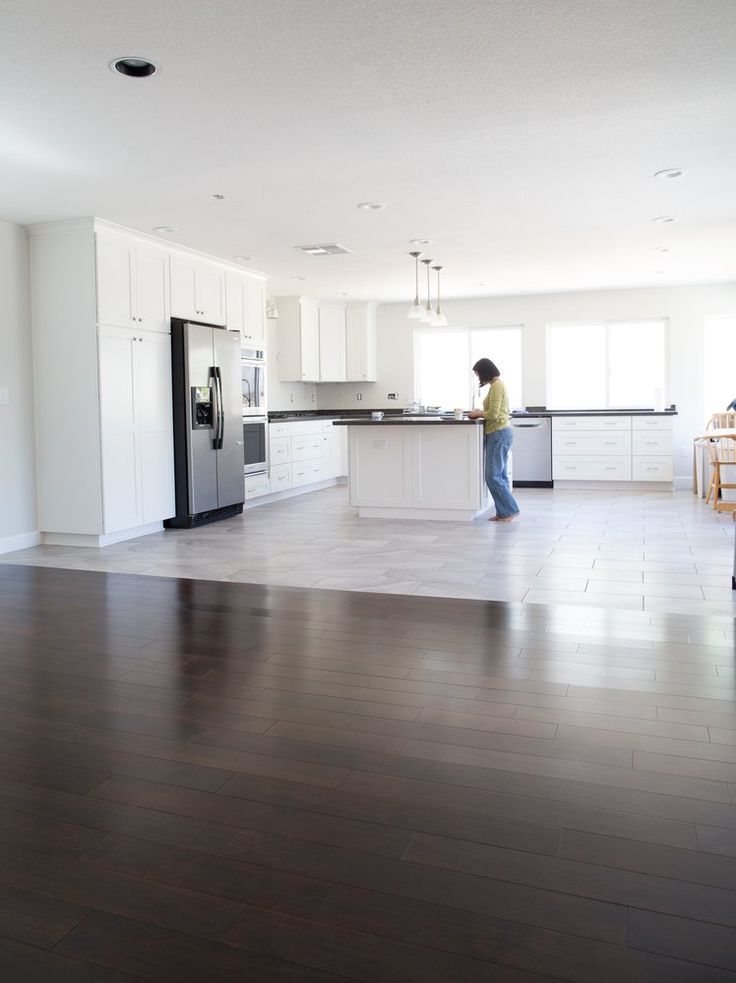
‘Hardwood timbers are perfect for busy living areas as they are durable and easy to maintain. There’s also the option to install underfloor heating, although not all solid wood floors are compatible: check with the manufacturer or installer. ’
Care of wood kitchen flooring needn’t be onerous. ‘Solid hardwood floors are easy to clean and maintain,’ David explains. ‘Vacuum or use a clean, damp mop weekly and remove rubber heel scuff marks and other non-water dispersible marks with a little white spirit on a damp cloth. Remove any excess of water on the surface immediately.’
Engineered wood kitchen flooring
(Image credit: Ted Todd)
An engineered wood floor could be a suitable option for your kitchen. It is still a real wood floor, and can have an appearance that’s hard to tell apart from solid wood flooring. So how is it distinguished from solid wood kitchen flooring, and does it have any advantages over it?
‘The main difference is the way the planks of flooring are constructed,’ explains Robert Walsh, owner and founder of Ted Todd Fine Wood Floors .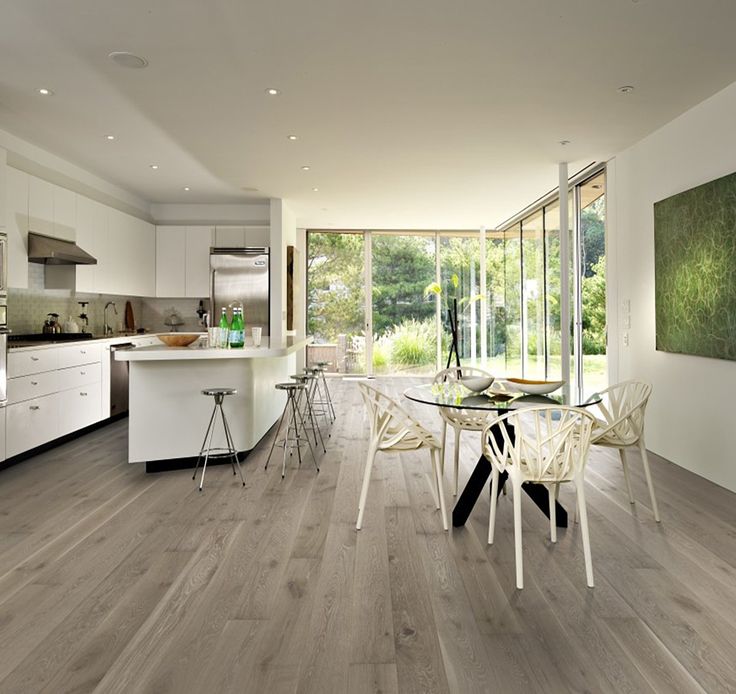 ‘Engineered wood floors are available as planks, parquet and panels and can be really transformative in any space.
‘Engineered wood floors are available as planks, parquet and panels and can be really transformative in any space.
'Created by layering sections of solid wood bonded together with the grain of each piece running in a different direction to its adjacent layer, it enhances the plank’s strength and resilience.
‘Layering wood in this way also reduces the wood’s natural tendency to expand and contract, meaning it is perfect to lay over underfloor heating and to use in areas like kitchens.
'The quality of an engineered wood floor is largely determined by the depth of the top layer of wood (known as the wear layer). The thicker the wear layer, the better in terms of look, feel, sound and durability.’
Reclaimed wood kitchen flooring
(Image credit: Ted Todd)
Reclaimed wood is another timber flooring option, and can be sourced either as solid wood or in the form of an engineered floor. But is it suitable for kitchens?
‘There is nothing to say that reclaimed and antique flooring shouldn’t be used in a kitchen area, especially if they have an engineered construction,’ says Robert Walsh. ‘It’s always best to avoid large build-ups of water when using a wood floor, but thanks to our in-house finishes, our antique and reclaimed woods are able to battle back against everyday splashes and spills.
‘It’s always best to avoid large build-ups of water when using a wood floor, but thanks to our in-house finishes, our antique and reclaimed woods are able to battle back against everyday splashes and spills.
‘Reclaimed pine, for example, is a wood that is naturally very clean and light, whilst having calming properties, making it ideal for use in the kitchen, whilst reclaimed teak resists rot, insects and decay, meaning it’s another lifetime choice for any room, including the kitchen.
‘Choosing reclaimed or antique wood kitchen flooring goes a lot further than buying character,’ he adds. ‘Reclaimed timber reduces environmental impact through re-use, helps to preserve forests by decreasing the need for new timber, and reduces any environmental footprints associated with producing a new wood floor.
'Wood flooring that has been crafted from reclaimed and antique wood not only gives the wood a new lease of life, it also prevents the need for more trees to be cut down.’
Wood lookalikes for kitchen flooring
If you’ve ruled out a wood floor for your kitchen because it isn’t appropriate for your kitchen’s location, your household, or your budget, there are alternatives which can create a similar look.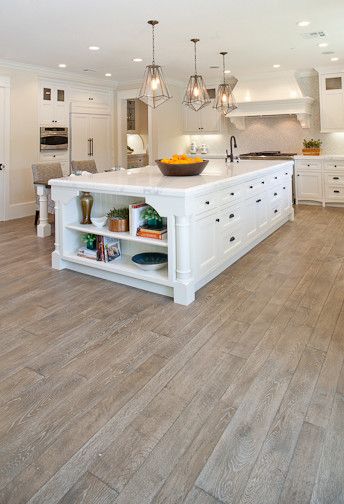
Luxury vinyl kitchen flooring ideas can have an authentic wood appearance thanks to today’s technology and manufacturing, and some vinyl tiles even have a wood-like texture. It is easy to clean and maintain.
Laminate has long been popular as an alternative to wood at a lower budget; it won’t look identical, of course, but can create a similar warm impression and caring for it isn’t hard work.
Consider tile, too. Both ceramic tile and porcelain can replicate the appearance of wood and prove easier to care for in a busy household.
What is the best wood floor for a kitchen?
The best wood floor for a kitchen will depend on your particular circumstances and lifestyle, but solid wood, engineered wood and reclaimed wood can all be possibilities.
‘One of the perks of solid wood is that it can easily be sanded down and re-finished in a different tone if you decide to re-decorate,’ says Rosie Ward.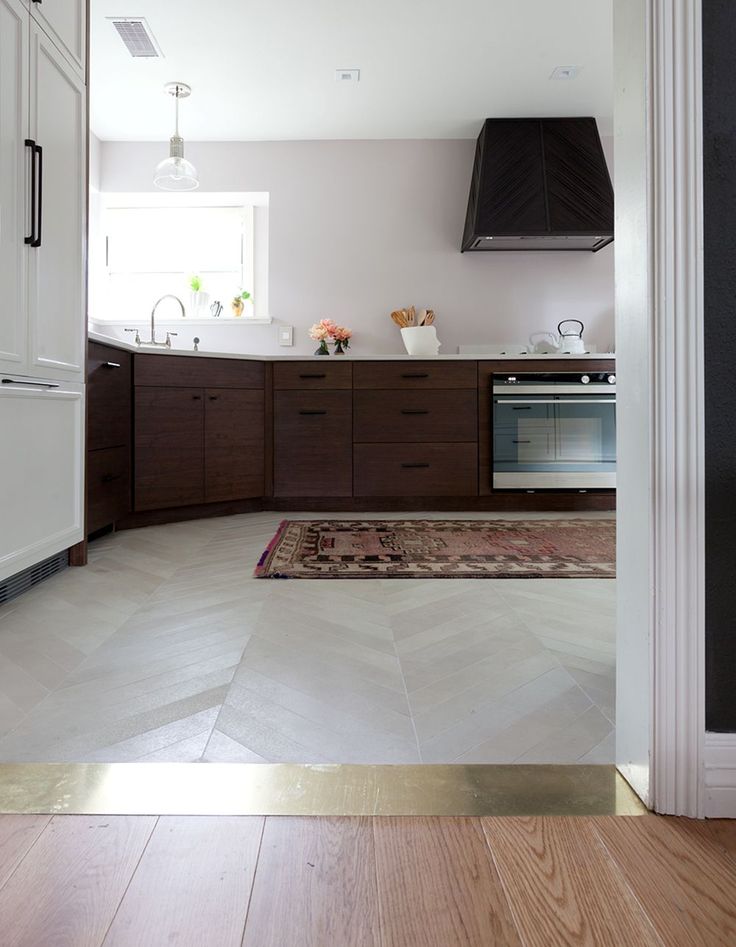 ‘I would go for a hardwood such as oak, maple or cherry, as opposed to a softwood, for greater longevity – it is worth the investment. Engineered wood is a more cost-effective option.
‘I would go for a hardwood such as oak, maple or cherry, as opposed to a softwood, for greater longevity – it is worth the investment. Engineered wood is a more cost-effective option.
‘Reclaimed flooring is more expensive than solid wood, but is the most sustainable wood kitchen flooring option.’
When you’re selecting wood kitchen flooring, think too about aspects such as the color, thickness, size and style of boards, advises David Papworth.
‘A wide board wooden floor really comes into its own in a large, open space where the plank width and length can be fully appreciated,’ he explains. ‘A more rustic and country-style look can be achieved by using a floor with lots of natural variations in the timber.
'The grading of the timber flooring makes a big difference to the appearance of the finished room – a more natural or rustic grade can make a large area look interesting, whereas a more uniform floor can add a very polished look to modern kitchens.
‘While oak is a perennial favourite, very pale floors make the most of natural light by reflecting it back into the room.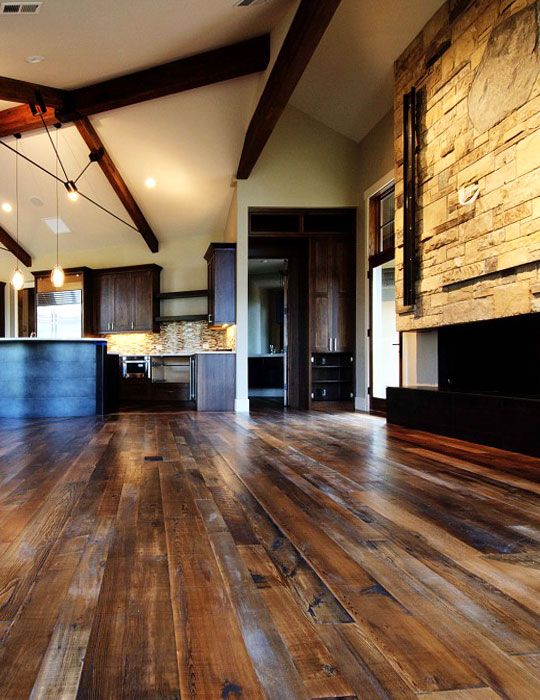 Choosing a dark floor can create wow factor and a more dramatic look. Parquet floors, especially herringbone patterns, are becoming more and more popular and they are now available in many different timbers and finishes.’
Choosing a dark floor can create wow factor and a more dramatic look. Parquet floors, especially herringbone patterns, are becoming more and more popular and they are now available in many different timbers and finishes.’
What is the best flooring for a kitchen?
The best flooring for a kitchen is one that has the visual appearance and feel you prefer, and suits your household and lifestyle in terms of durability and maintenance.
Balancing up these elements when choosing the best kitchen flooring for you is crucial for a successful room design and flooring that stands the test of time.
Wood kitchen flooring is the right choice for many and solid wood, engineered and reclaimed all have their individual merits.
If you are concerned about kitchen flooring costs, though, a wood lookalike in vinyl, tile or laminate (see above) can provide a similar appearance on a budget, although the feel will be different.
If you want a flooring material from nature but wood isn’t right for your home, natural stone tile, properly sealed, is easy to look after and hard wearing.
Sarah is a freelance journalist and editor. Previously executive editor of Ideal Home, she’s specialized in interiors, property and gardens for over 20 years, and covers interior design, house design, gardens, and cleaning and organizing a home for H&G. She’s written for websites, including Houzz, Channel 4’s flagship website, 4Homes, and Future’s T3; national newspapers, including The Guardian; and magazines including Future’s Country Homes & Interiors, Homebuilding & Renovating, Period Living, and Style at Home, as well as House Beautiful, Good Homes, Grand Designs, Homes & Antiques, LandLove and The English Home among others. It’s no big surprise that she likes to put what she writes about into practice, and is a serial house renovator.
Engineered Hardwood in Kitchen (Pros and Cons)
Engineered hardwood flooring in the kitchen is beautiful, and can cost way less than traditional hardwood. Engineered hardwood flooring refers to the product made out from a core of hardwood or plywood of about three to twelve layers which are pressed together by means of cross layering and gluing.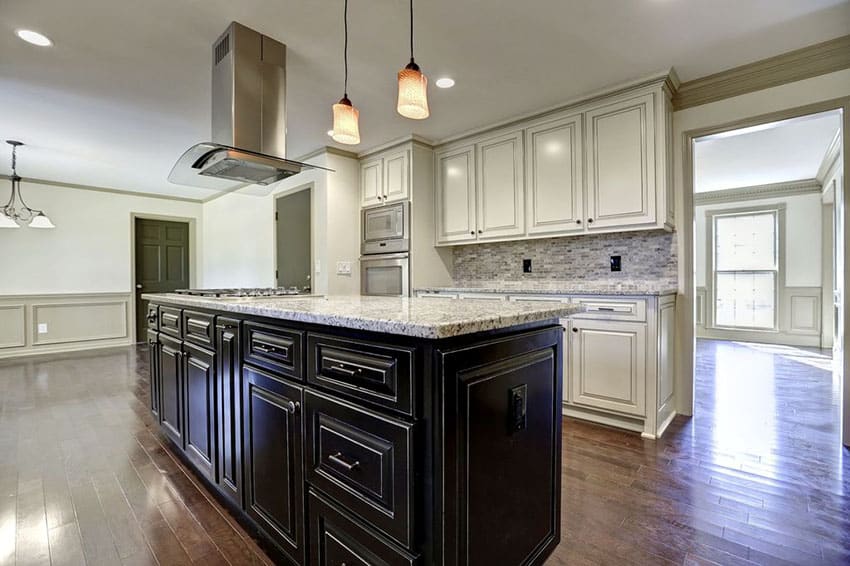 There is a top layer of hardwood veneer being glued on the core’s top spot. There is availability of this kind of flooring for almost any kind of wood species. Visit this page for more info about the pros and cons of solid hardwood floors in the kitchen.
There is a top layer of hardwood veneer being glued on the core’s top spot. There is availability of this kind of flooring for almost any kind of wood species. Visit this page for more info about the pros and cons of solid hardwood floors in the kitchen.
An advantage of making use of engineered wood floors is that it has more resistance to moisture levels compared to the solid wood flooring. In this connection, it can be installed in damp basements or spaces which have either higher humidity or lower humidity than normal levels. It can be easily installed by directly gluing it down over the dry concrete slabs on top or below grade or stapling it down over the wood subfloor.
Engineered hardwood floors come in variety of widths from three to seven inches and in different thickness from three-eighth to three-forth inch. They also come in various domestic and exotic hardwood species. These kind of wood floors are manufactured in two ways. Firstly, the sliced or sawn cut wherein the top surface wear layer is cut from the log showing a natural appearance of wood and projects a finer graining. Also, this kind of cut is able to allow a thicker wear layer. Secondly, the rotary cut wherein the veneer hardwood wear layer is being peeled off the log by means of using big lathes. Its peeling method can have wilder graining.
Also, this kind of cut is able to allow a thicker wear layer. Secondly, the rotary cut wherein the veneer hardwood wear layer is being peeled off the log by means of using big lathes. Its peeling method can have wilder graining.
Pros
– Looks amazing and costs much less than solid wood floors
– Modern engineered wood floors are virtually indistinguishable from solid wood flooring
– Wide variety of wood types and finishes available
– Can be sanded and refinished repeatedly, but not as frequently as solid wood floors
– Generally more receptive to changes in weather, and more resistant to moisture and humidity than regular wood flooring- Can be installed over under floor heating unlike real hardwood
Cons
– It is not real solid wood flooring which may be an irritation to some people.
– The lifespan of engineered wood flooring is not near as long as real wood
It is important to know your own demands regarding the flooring of your kitchen. Be aware of what type of materials that you want installed. If the preferred area for the new flooring will be frequently walked-through and encounter daily foot traffic then the engineered floor is most likely the best choice. In this way, you will have less maintenance. With its thick wear layer you can just sand and refinish the floor if there is a need to. An area that does not being walked-through many times does not necessarily need a thick wear layer. Indeed, engineered floors are very much durable for areas receiving much more foot traffic.
Be aware of what type of materials that you want installed. If the preferred area for the new flooring will be frequently walked-through and encounter daily foot traffic then the engineered floor is most likely the best choice. In this way, you will have less maintenance. With its thick wear layer you can just sand and refinish the floor if there is a need to. An area that does not being walked-through many times does not necessarily need a thick wear layer. Indeed, engineered floors are very much durable for areas receiving much more foot traffic.
Engineered wood is regarded as most closely aligned to a solid hardwood. It as well has a resemblance when it comes to the price. By using it, the resale value of the house becomes higher as well. With regards to installation, it falls under moderate difficulty. It goes through the process of stapling and gluing to the sub-floor just like the solid hardwood but there is a possibility of purchasing floating engineered flooring which can ride with independence on the subfloor.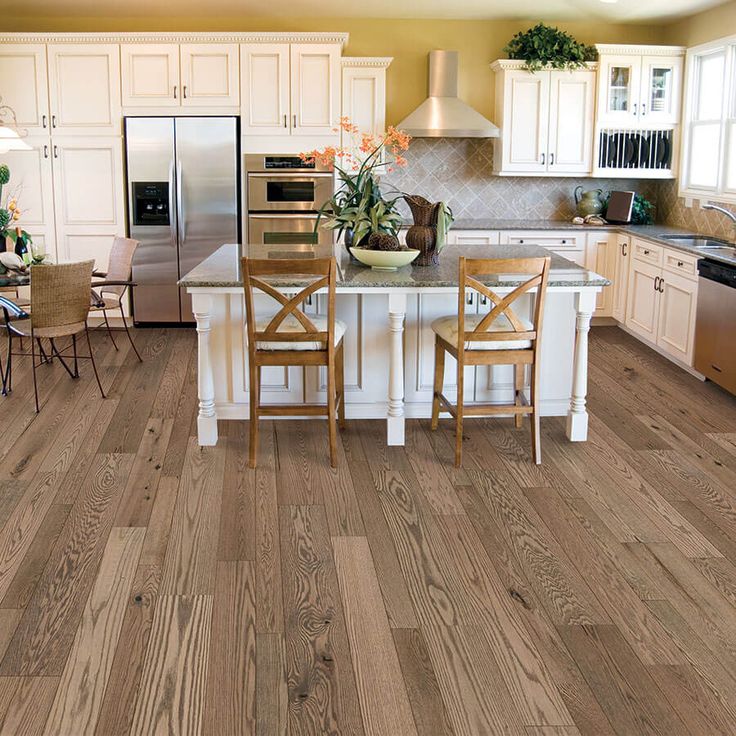 Mostly, these kinds of floors can be installed in any room with the exception of rooms that are highly prone to moisture like the bathrooms. The product is made out of wood which has little conduction to cold making the surface warm for comfort.
Mostly, these kinds of floors can be installed in any room with the exception of rooms that are highly prone to moisture like the bathrooms. The product is made out of wood which has little conduction to cold making the surface warm for comfort.
Here’s a short video on how to install floating engineered hardwood flooring.
Related Kitchen Interior Design Articles You May Like
Types of Kitchen Flooring – Kitchen Design Ideas – Kitchen Remodel Cost Guide – Solid Wood Kitchens – Hardwood Floors in Kitchen Pros and Cons
Parquet in the kitchen pros and cons. Should I put parquet in the kitchen
What kind of flooring does everyone associate a kitchen with? Ceramic tiles, laminate, linoleum. Few people will say solid wood parquet as the first option. This attitude to the parquet board is not accidental. The kitchen is a room with increased loads and impacts on any material that is used in the interior. Temperature changes, exposure to moisture, the spread of odors that can be absorbed - all this negatively affects wood products. And initially, parquet was just a wooden plank that could be varnished. Therefore, there was such an opinion about the use of wood as a floor covering for the kitchen. Is it possible to use modern parquet for the kitchen? Consider all the pros and cons and try to answer this question.
The kitchen is a room with increased loads and impacts on any material that is used in the interior. Temperature changes, exposure to moisture, the spread of odors that can be absorbed - all this negatively affects wood products. And initially, parquet was just a wooden plank that could be varnished. Therefore, there was such an opinion about the use of wood as a floor covering for the kitchen. Is it possible to use modern parquet for the kitchen? Consider all the pros and cons and try to answer this question.
Advantages and disadvantages
Naturally, we will consider parquet made using modern production technologies. Technology does not stand still, so the parquet board is now able to withstand all influences to a certain extent.
Pros:
- natural and ecological;
- tactile sensations;
- ease of installation;
- compatible with various styles;
- durability;
- impact protection.
Of course, the floor made of parquet or parquet board looks natural and beautiful, it is a pleasure to walk on it, even barefoot. Wood does not exude harmful substances, unless you use some kind of varnish or other coating that is not suitable for the kitchen. A variety of shapes and colors allow parquet to be combined with different styles of rooms, such as country, provence, hi-tech, modern, etc.
Wood does not exude harmful substances, unless you use some kind of varnish or other coating that is not suitable for the kitchen. A variety of shapes and colors allow parquet to be combined with different styles of rooms, such as country, provence, hi-tech, modern, etc.
Modern production technologies, multi-layer, multiple varnishing layers allow modern parquet products to easily compete with other materials in terms of protection from various influences and durability.
Looking at the advantages, I would like to say that this material is a worthy floor covering for the kitchen. But the full picture is not yet clear. Not enough data on deficiencies. Let's consider them.
Minuses:
- cost
- special care;
- is subject to mechanical damage;
- for parquet board: if one part is damaged, the whole line will have to be changed.
The price of solid wood products is an order of magnitude higher than that of laminate, ceramic tiles or linoleum.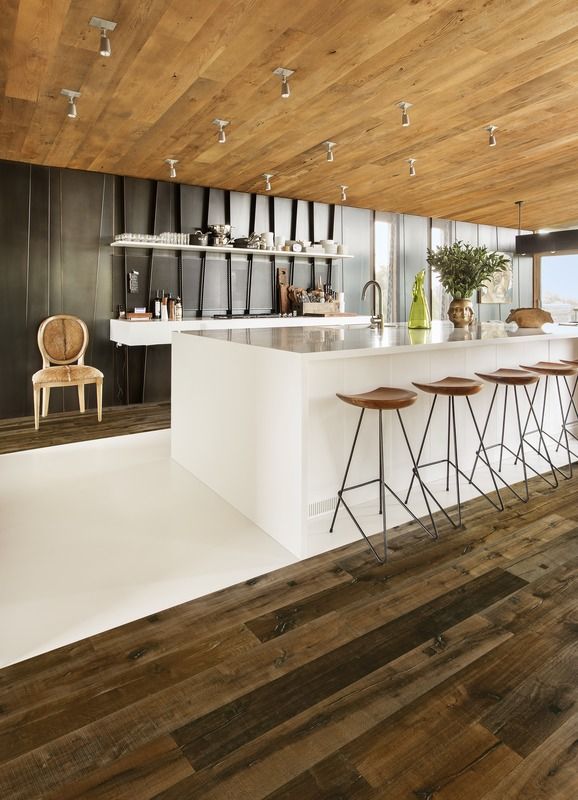 Despite certain protective functions that protect the material, proper and careful care of the parquet or board is necessary. Wash with special detergents. If wine or other liquid gets on the surface, it is necessary to immediately wipe the stains, otherwise the parquet may be painted. Furniture legs must be equipped with plugs so as not to damage the parquet board. Staying in water for a long time can lead to swelling, so if you are flooded and no one was home, you will most likely need to change the coating. For a parquet board, changing one detail is quite difficult. you have to change the whole lane.
Despite certain protective functions that protect the material, proper and careful care of the parquet or board is necessary. Wash with special detergents. If wine or other liquid gets on the surface, it is necessary to immediately wipe the stains, otherwise the parquet may be painted. Furniture legs must be equipped with plugs so as not to damage the parquet board. Staying in water for a long time can lead to swelling, so if you are flooded and no one was home, you will most likely need to change the coating. For a parquet board, changing one detail is quite difficult. you have to change the whole lane.
What conclusion can be drawn from all of the above? Wood parquet has a large set of positive qualities, and some disadvantages. But with proper care, they can be minimized. Therefore, it is possible and necessary to use a parquet board as a floor covering. The main question is which wood to choose.
How to choose the type of wood
There are many types of wood used as the basis for parquet.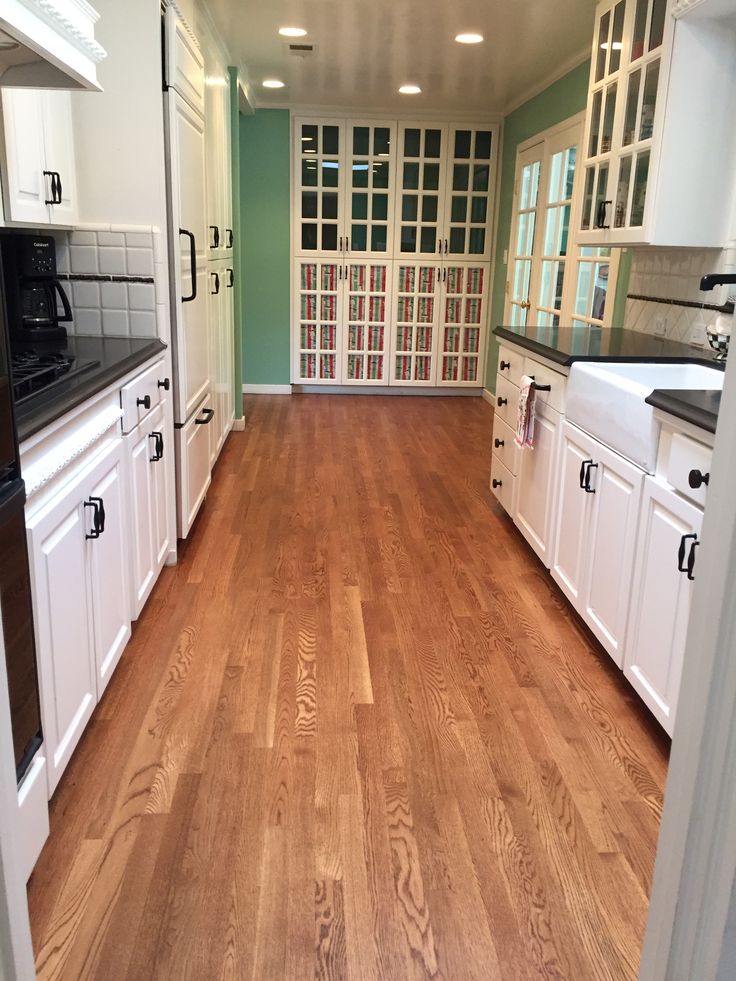 Consider the most suitable for operating conditions in the kitchen.
Consider the most suitable for operating conditions in the kitchen.
The most popular and proven material for parquet is oak. The main features are durability and water-repellent properties. A variety of shades makes it possible to choose a floor covering for any style and color scheme. the only thing that can keep you from buying such material is the cost. The price of such products is noticeably higher than analogues from other wood.
Another great option for the kitchen is teak. Due to the increased content of rubber and tektol, the material has water-repellent properties, a strong structure and is not susceptible to insect attacks.
Ash would be an excellent option. It is easy to process and impregnate. Strength indicators are higher than those of oak. And beautiful shades and texture will make a unique and pleasant interior in the kitchen.
Walnut has a good set of characteristics for use in the production of parquet.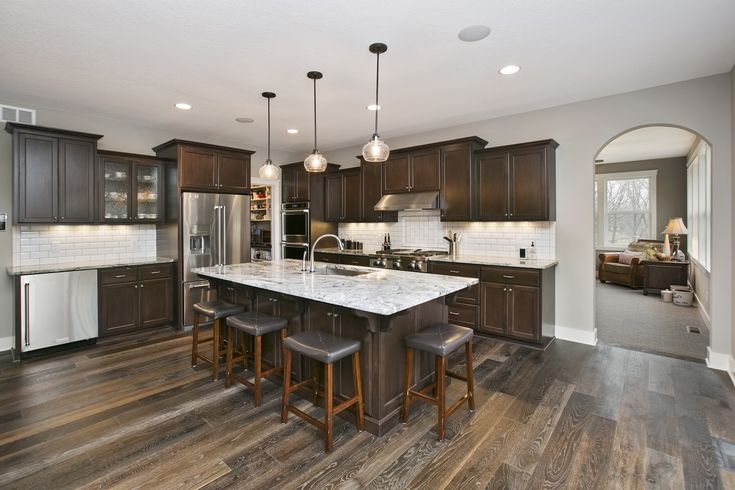 But it has a dark shade with a slight variegation. This color is not suitable for every interior.
But it has a dark shade with a slight variegation. This color is not suitable for every interior.
Exotic woods are perfect for their characteristics and colors: jatoba, merbau, sucupira, sapele.
Maple and beech have a soft texture, so their use in the kitchen is not recommended.
It is worth mentioning the bamboo parquet separately. Due to the peculiarities of production, it has the best performance in terms of protection against the harmful effects of various environments. at the same time, wood does not need additional measures to protect it from environmental influences.
Do not be afraid to buy parquet or parquet board to install in the kitchen. Properly selected material, careful care and high-quality installation will extend the life of such a coating and create an atmosphere of comfort and beauty.
tips for choosing and laying flooring
We are all used to seeing tiles, linoleum, porcelain stoneware or laminate on the kitchen floor. However, not everyone is satisfied with such materials - this is quite understandable, because each of them has its own disadvantages and advantages that can tip the scales of your choice in one direction or another. Let's look at the features of these coatings.
However, not everyone is satisfied with such materials - this is quite understandable, because each of them has its own disadvantages and advantages that can tip the scales of your choice in one direction or another. Let's look at the features of these coatings.
What to lay on the kitchen floor
- Everyone is already pretty fed up with linoleum on the kitchen floor, besides, it wears out pretty quickly. Hot splashes may damage this material;
- Porcelain stoneware flooring resists hot oil, boiling water and cigarette ash. This material washes well and is not afraid of moisture, perfectly 'friendly' with warm floors. However, porcelain stoneware is very "cold" and "hard", if you drop a plate on it, it will inevitably break. In addition, in an unpolished form, it looks unpresentable, and polished, especially wet, it is very slippery and, slipping on it, you can get seriously injured;
- The same can be said about the tiles laid in the kitchen, the floor of which is cold even in summer.
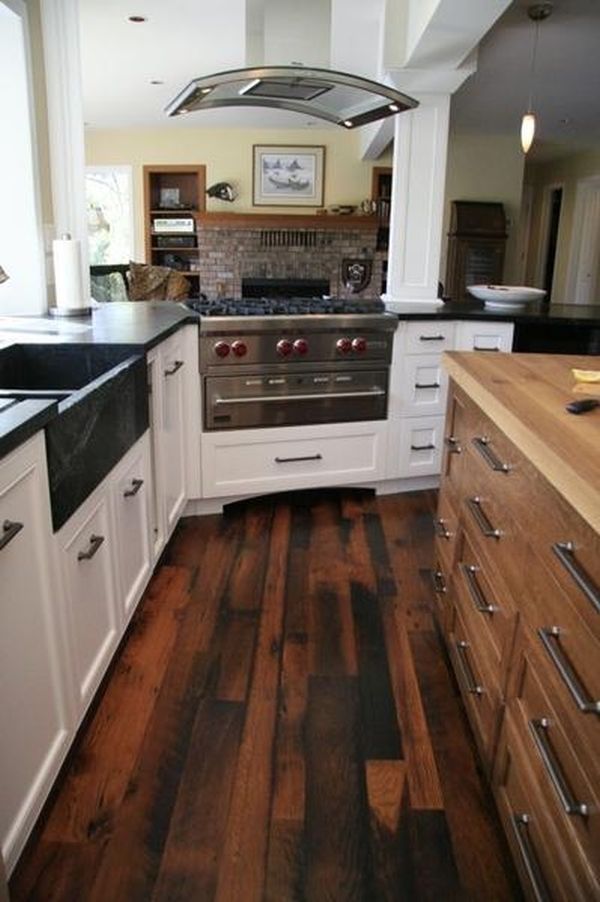 Unlike porcelain stoneware, the pattern on the tile can wear off over time, and the appearance of the coating becomes unaesthetic. In addition, tile can break when heavy objects fall on it;
Unlike porcelain stoneware, the pattern on the tile can wear off over time, and the appearance of the coating becomes unaesthetic. In addition, tile can break when heavy objects fall on it; - Laminate is considered an excellent option for the kitchen. However, some do not like him because of his unnaturalness, besides, he is cold and "noisy". To avoid "noisiness", you need to lay a cork substrate under the laminate, and this entails additional expenses.
That is why people began to lay parquet boards in the kitchen. This material attracts with its warmth and "naturalness". In addition, some especially aesthetic tenants want the floors in the entire apartment to look like a single whole. Manufacturers have no choice but to meet the needs of customers and create parquet boards that are not afraid of moisture, steam and oil splashes.
Things to remember when laying parquet boards in the kitchen
- In the kitchen, parquet boards will last longer if you use wood types that are more neutral with respect to water.
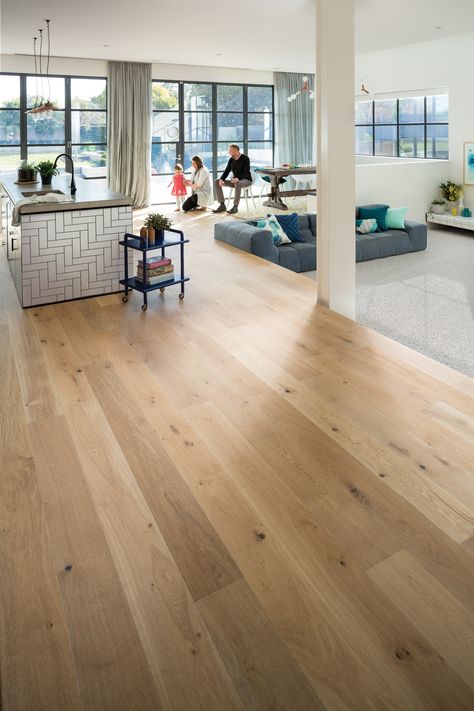 These are oak, teak, merbau and larch. In addition, you need to purchase a high quality board to be sure of the quality of the wood;
These are oak, teak, merbau and larch. In addition, you need to purchase a high quality board to be sure of the quality of the wood; - Do not install wood species that do not tolerate moisture well on the floor in the kitchen: ash, beech or maple. the color of the laminate, and so that it does not “noise”, lay a cork substrate under the laminate from below;
- For installation of a warm floor “under the parquet”, it is necessary that the screed be laid on the heating mats with a layer of 3 to 10 mm, then the heating will be more uniform and the parquet gloss will not deform;
- It will be necessary to attach soft material to the legs of kitchen furniture so that the parquet board does not lose its aesthetic appearance during operation;
- If you have underfloor heating installed, you need to approach the choice of parquet board very thoughtfully, and choose the one that can be laid on the “warm floor”. A two-layer hardwood flooring is best for this purpose, but some models of a three-layer board will also work for this case.
 Such a variant of parquet exists, but it is much more expensive than the one that is usually laid in residential premises;
Such a variant of parquet exists, but it is much more expensive than the one that is usually laid in residential premises; - When operating such a floor, it should be remembered that wood is a poor conductor of heat and correctly build the temperature regime.
Karelia parquet board is not afraid of moisture and temperature fluctuations
Finnish Karelia parquet board is designed in such a way that it perfectly tolerates temperature fluctuations, as it has a top quality wood layer. To prevent such floors from rotting, larch or northern pine is used as the material for the bottom layer, which perfectly resist the appearance of mold and do not deform. This company produces parquet models that can be laid on a warm floor, both with electric and water heating.
- The Profiloc locking joint allows this flooring to be laid without gaps, which also helps to prevent moisture from penetrating under the parquet, and the special technology by which the edges are cut makes it possible to obtain an almost airtight flooring.
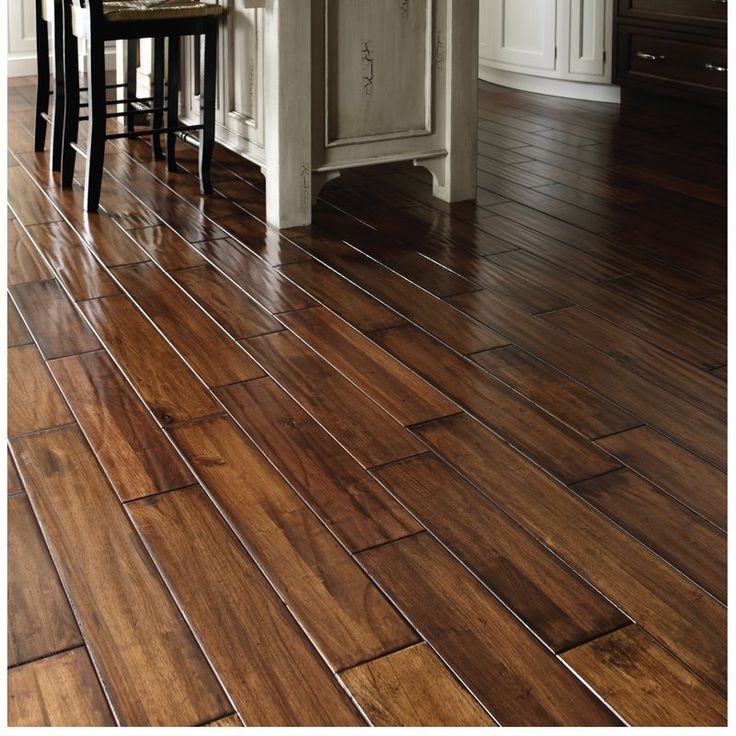 This makes parquet boards produced by this brand an excellent option for those who want to have just such floors in the kitchen. Thanks to Karelia products, kitchen and parquet have become compatible;
This makes parquet boards produced by this brand an excellent option for those who want to have just such floors in the kitchen. Thanks to Karelia products, kitchen and parquet have become compatible; - The edges of the Karelia parquet board elements are treated with a special wax composition, which makes the floor waterproof. This prevents the floor from swelling and cracks;
- For the manufacture of such parquet, a special varnish is used, the wear resistance of which is quite high. In addition, such lacquered parquet does not slip even when wet, which reduces the risk of household injuries in the kitchen, such a coating allows you not to be afraid that wet cleaning will ruin the floors. If Karelia parquet is laid in the kitchen, you can wash the floor several times a day - this will not harm it at all;
- The thickness of the top layer of Karelia parquet is such that in the event of surface damage it can be sanded two or three times;
- This well-known brand produces parquet boards that are not inferior in quality to natural solid wood parquet.

